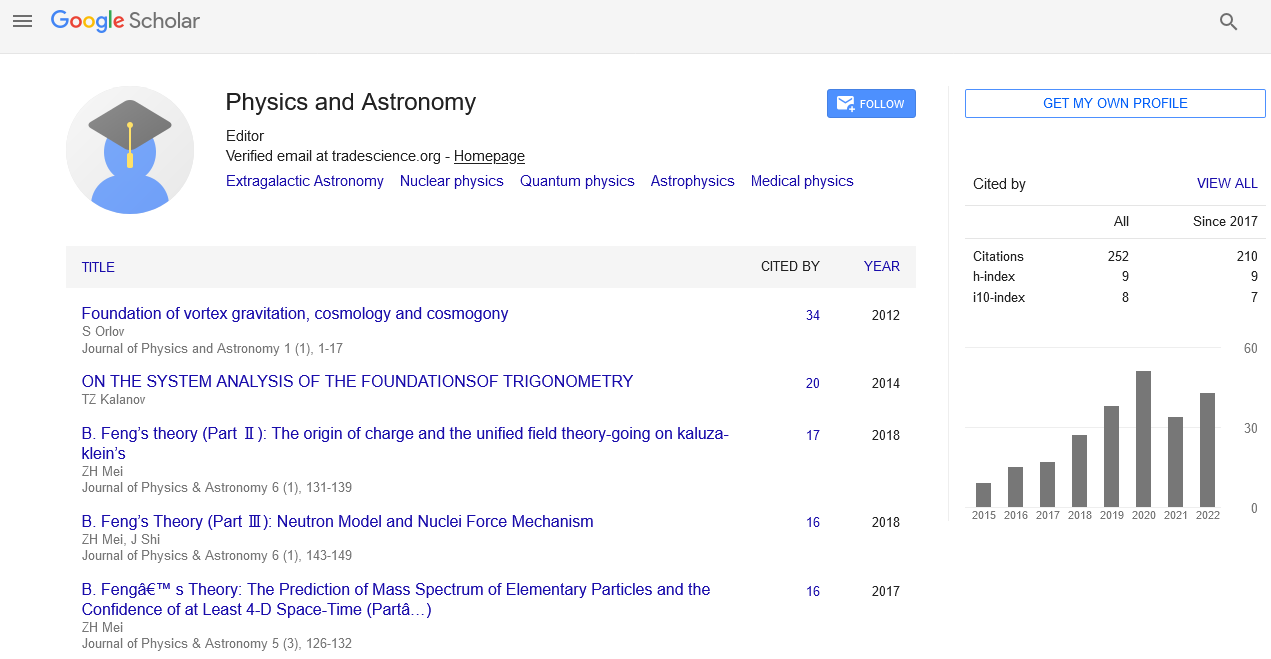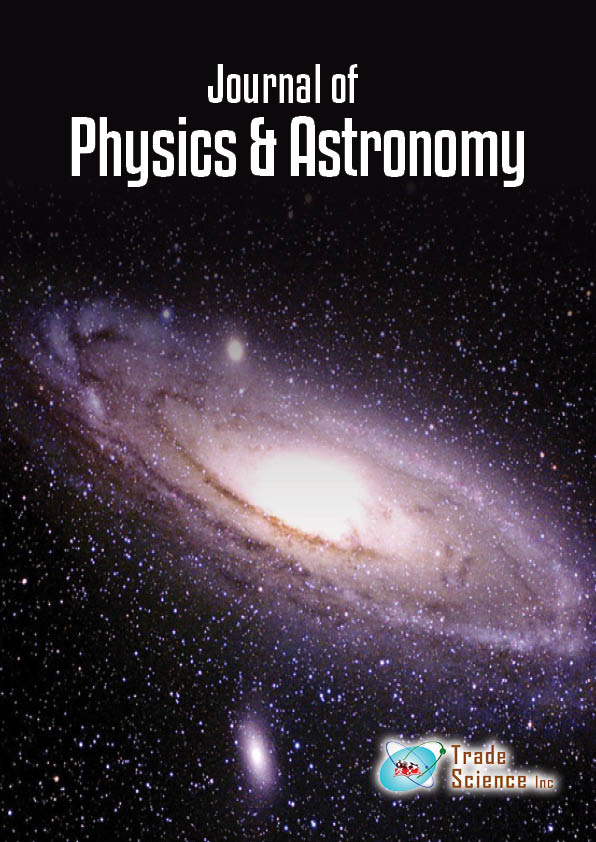Image Article
, Volume: 13( 1) DOI: 10.37532/2320-6756.2025.13(1).405Newton’s Second Law and Relativistic Hamiltonian. Part I. Theoretical
- *Correspondence:
- Yu. E. Zevatskiy
Department of Physical Engineering, School of Medicine, Georgetown University, Washington, USA
E-mail: galacticelephant@gmail.com
Received: September 14, 2023, Manuscript No. TSPA-23-113825; Editor assigned: September 18, 2023, PreQC No. TSPA-23-113825 (PQ); Reviewed: October 03, 2023, QC No. TSPA-23-113825; Revised: January 09, 2025, Manuscript No. TSPA-23-113825 (R); Published: January 16, 2025, DOI. 10.37532/2320-6756.2025.13(1).405.
Citation: Zevatskiy YE. Newton’s Second Law and Relativistic Hamiltonian. Part I. Theoretical. J Phys Astron. 2025;13(1).405.
Introduction
The relativistic kinematics and particle dynamics in the four-dimensional Euclidean space with real reference axes have been studied using the Lorentz transformations. Five types of relativistic Hamiltonians of particles moving in the field of potential forces are calculated, depending on the recording form of the Newton’s second law. The results obtained can be applicable to introduce relativistic corrections while solving a wide variety of problems in mechanics.
Lorentz transformations underlie the special theory of relativity and they can historically be considered as the basis for the other relativistic theories. The covariance property of physical models under Lorentz transformations is a key criterion for their applicability in practice [1,2]. The concept “local time”, introduced by Lorentz, has changed the essence of basic physical concepts such as impulse, force and led to quantitative changes in the wording of laws associated therewith. Despite the fact that the first works of Lorentz on the theory of relativity date back to the end of the 19th century, they are still relevant today.
In this study, we will derive the relativistic Hamiltonian of a particle from the expression for the range of its proper (local) time, invariant under Lorents transformations.
It is known that a value is

invariant under arbitrary nonhomogeneous Lorentz transformations [3].
Δx=x2–x1, Δy=y2–y1, Δz=z2–z1, Δt=t2–t1, Δτ=τ2-τ1. The following notations are introduced: x1, y1, z1, t1–coordinates and occurrence time 1 in the frame of reference selected, x2, y2, z2, t2-coordinates and occurrence time 2 in the frame of reference selected. If event 1 is the position of the body preceding the position of the body in event 2, then τ1 is an instant of time of event 1, measured against the clock associated with this body, and τ2 is an instant of time of event 2, measured against the same clock. It is no wonder that interval Δτ will be the same with regard to any inertial reference frames as it is measured, using the same clock. Shall we transform expression (1), passing from intervals to differentials:
ds2= dw2 + dr2 , (2)
where the following notations are introduced:
ds=cdt, dw=cdτ, dr=idx+jdy+kdz, I, J, K are unit axes of spatial reference system. Under expression (2) it follows that:

where the notation of the squared velocity of the body in the selected system is introduced

Under equation (2) it also follows that

or in selected notations, using equation (3):

Shall we multiply the left and right part of equation (6) by the product of the squared invariant body mass m0 and squared light velocity, and we get

What is the basic relativistic expression [4,5] within a constant multiplier? Introducing the traditional concept of the observable (relativistic) mass

expression (6) can be rewritten as follows:
(mc)2=(m0c)2+(mv)2 , 6(a)
which can be interpreted as the addition law of orthogonal spatial (explicit) momentum
Pr= mv (8)
and own (hidden) momentum directed along the local time coordinate w
P0= m0c , (9)
with the formation of resultant (total) body momentum
P=Pr + P0 ; P=mc . (10)
Thus, the relativistic kinematics can be considered in four-dimensional Euclidean space, i.e. local (proper) time. All coordinate axes are real. All bodies, inert and moving relative to the selected coordinate system in this tetrameric space, make constant movements with a speed equal to the light-speed.
To consider the relativistic dynamics of the motion of bodies, the form of Newton’s second law of motion needs to be defined. There are four levels of Newton’s second law. The classical one:

Traditional relativistic one:

proposed by Lorentz and confirmed in experiments with β-rays at the beginning of 20th century [4].
Theoretically inverse relativistic one:

and local one:

In all cases, the differential of the potential energy of the potential-field forces is equal to:
dU = -Fdr ......12
To obtain relativistic motion integrals, shall we differentiate expressions (3) or (5) in order to obtain the total differential of the form:

where H is a function of two independent variables U and v2
H(U, V2 ) = const . ....14
For instance, the differential of equation (3), using the form (11?) of Newton’s second law,

can be rearranged into a differential equation:

By integrating we obtain an expression for the classical Hamiltonian up to a constant of integration:

The differential of equation (5), using the traditional relativistic form (11b) of Newton’s second law

can be rearranged into a differential equation:

By separating the variables and integrating we obtain an expression for the relativistic Hamiltonian :

Using the law (11c), the differential (3):

can be rearranged into (17?)

The integration of the second equation (17a) provides an expression similar to the relativistic Lagrangian [5,6].
The difference is expressed in marks:

To correspond (17b) to the classical Hamiltonian in the classical limit β → 0, the constant should be given the value m0c2 – H. Thus:

The differentiating of the equation (3) gives

Using the Newton’s law in the form (11d), the equation can be rearranged as follows:

By integrating and removing the constants, we obtain:

The case when Fdr=0 should be considered separately. The values of U and β are kept constant during this movement. Using the classical level of Newton’s second law (11a) the expression for Hamiltonian H0 will not be changed. The Lorenz traditional relativistic (11b) and inverse relativistic (11c) levels of Newton’s second law will coincide:

Thus, the differentiating of the equation (3) using the form (19)

gives the differential equation:

By integrating, the form of the Hamiltonian coincides with the expression (17c)
H12=H2
The local level of Newton’s second law under the condition β=const will be changed:

which, by substituting into the differential of equality (3) gives

By integrating (24) we obtain the following expression

The results obtained are summarized in the below Table:
| Recording form of the Newton’s second law | Type of Hamiltonian | |
|---|---|---|
| Fdr ≠ 0 | Fdr=0 | |
 |
 (40) (40) |
|
 |
 |
 |
 |
 |
|
 |
 |
 |
The second summands in equations (16b), (17c), (18b), (25) and (26) can be interpreted as an expression of the kinetic energy of a particle in the field of potential forces at the value of its potential energy U.
On expanding the logarithm in a power series β, these summands give the series in which only the first term coincides (m0v2/2). The difference in values of the kinetic energy, calculated, for example, by expressions (16b) and (25), at β=0.1 equals 0.3 %, and at β=0.5 reaches 7.5%.
The applicability of the considered formulas for calculating the Hamiltonian should be evaluated in a variety of experiments. Numerical calculations of relativistic effects in determining the spectra or ionization potentials of atoms and ions may suit this purpose. Apparently, for processes involving electrons, the most accurate expression will be (16b), obtained from Newton's second law, in the form proposed by Lorentz. This may not be the case in other processes.
References
- Pauli W. Theory of relativity. Pergamon Press, 1958.
- Levi-Civita T. Fundaments of relativistic mechanics Bologna: Nicola Zanichelli, MCMXXVIII.
- Moller C. The theory of relativity. Oxford: Clarendon Press, 1972.
- Einstein A. The meaning of relativity. Princenton, 1953.
- Landau LD, Lifshitz EM. Course of theoretical physics. 2. The classical theory of fields, Oxford: Pergamon Press, 1975.
- Landau LD, Lifshitz EM. Course of theoretical physics. 1: Mechanics, Oxford: Butterworth-Heinemann, 1976.

